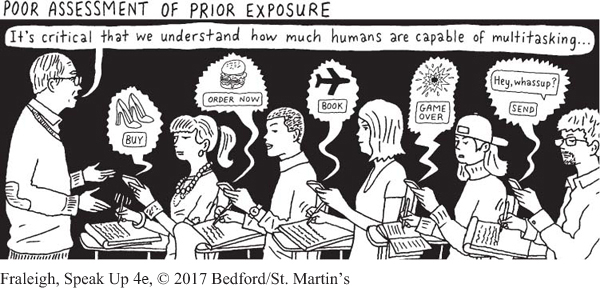Identifying Prior Exposure
Do you remember getting a lecture from your parents or teachers that you had heard before—
Analyzing your audience also includes gauging listeners’ prior exposure11—the extent to which they have already heard your message. The degree of this prior exposure should guide you either to include particular points in your speech or to craft something entirely new. How can you determine whether your audience has had prior exposure to your topic—
Page 143

Has My Audience Heard This Message Before? If your answer is no, your listeners have had zero prior exposure and will have no preconceived notions about or positions on your message. You can craft your message as you want, but you may have to explain all relevant issues and concepts in basic terms. If your answer is yes, your audience has had prior exposure. Move on to the second question.
Has My Audience Responded Positively to the Message? If the goal of an earlier speech on your same topic was persuasion, consider whether audience members actually engaged in the actions or adopted the beliefs the speaker advocated. If the purpose of that earlier speech was to inform, determine whether audience members became interested in the subject and understood the information the speaker presented.
If you answer yes—
If you answer no—
Why Did the Previous Message Fail? Assess what went wrong the last time your audience heard the message. Then use the resulting insights to tailor a more successful approach. In the case of Henry’s speech, he would have benefited from asking his classmates why they disagreed with his position in his first speech. Perhaps he would have discovered that some of them questioned his knowledge of science, some of them knew about climate change only from what they had heard on television, and some may have found him a bit arrogant. Knowing the answers to this question would have given Henry other options for his second speech.
Page 144
Additionally, if your audience has had a major change in perspective since the previous presentation, consider whether you need to adjust your message to accommodate listeners’ new viewpoints. For example, during the 2008 presidential campaign, Barack Obama pushed for universal health care coverage. Given his win, Democrats assumed that support for the new president would translate into ongoing backing of the health care bill. However, in late 2009, many members of Congress found themselves confronted by angry constituents who were not amenable to the bill.
What happened? Democrats had failed to ask themselves whether anything had changed for voters since their prior exposure to the message. And something had changed—